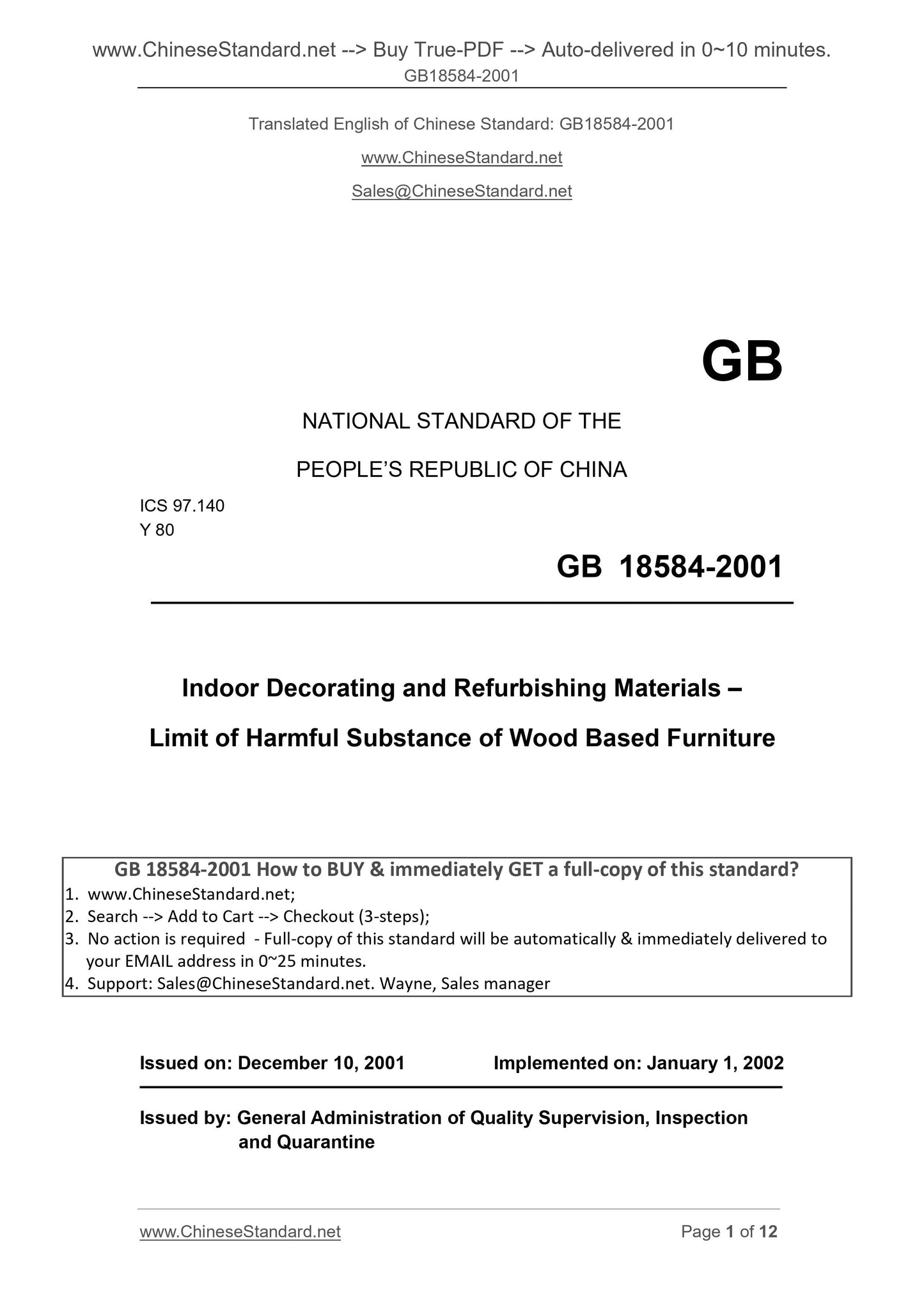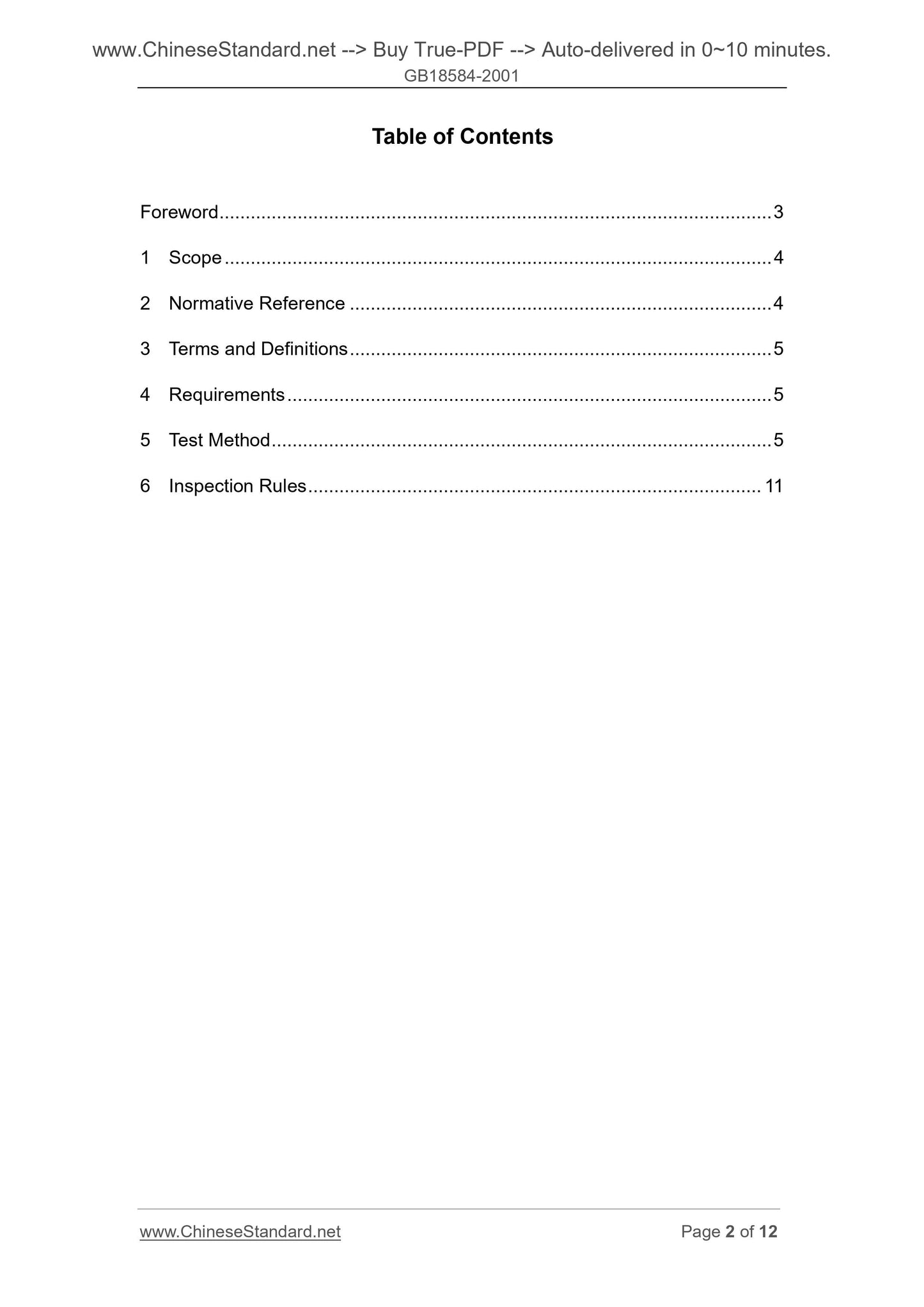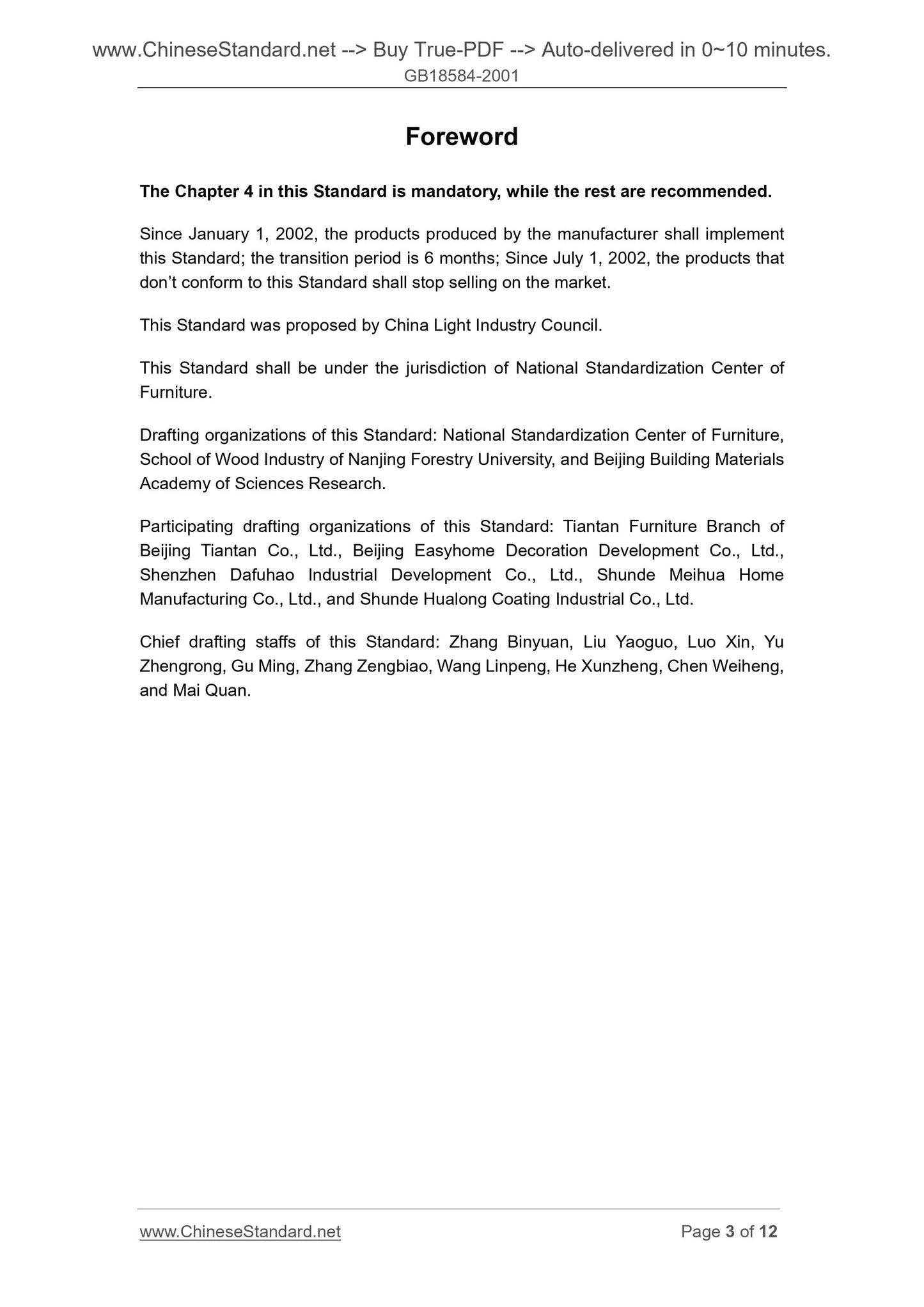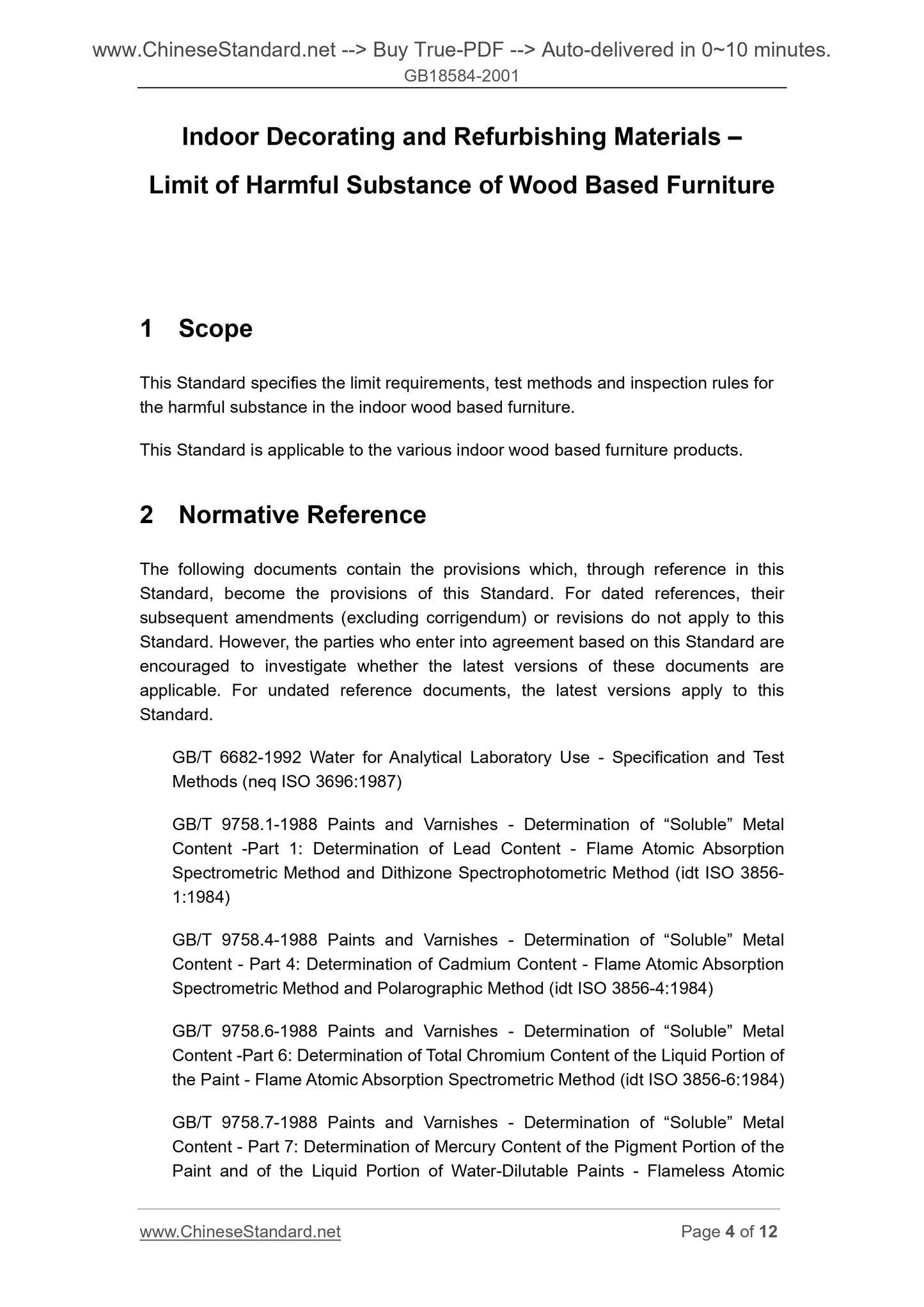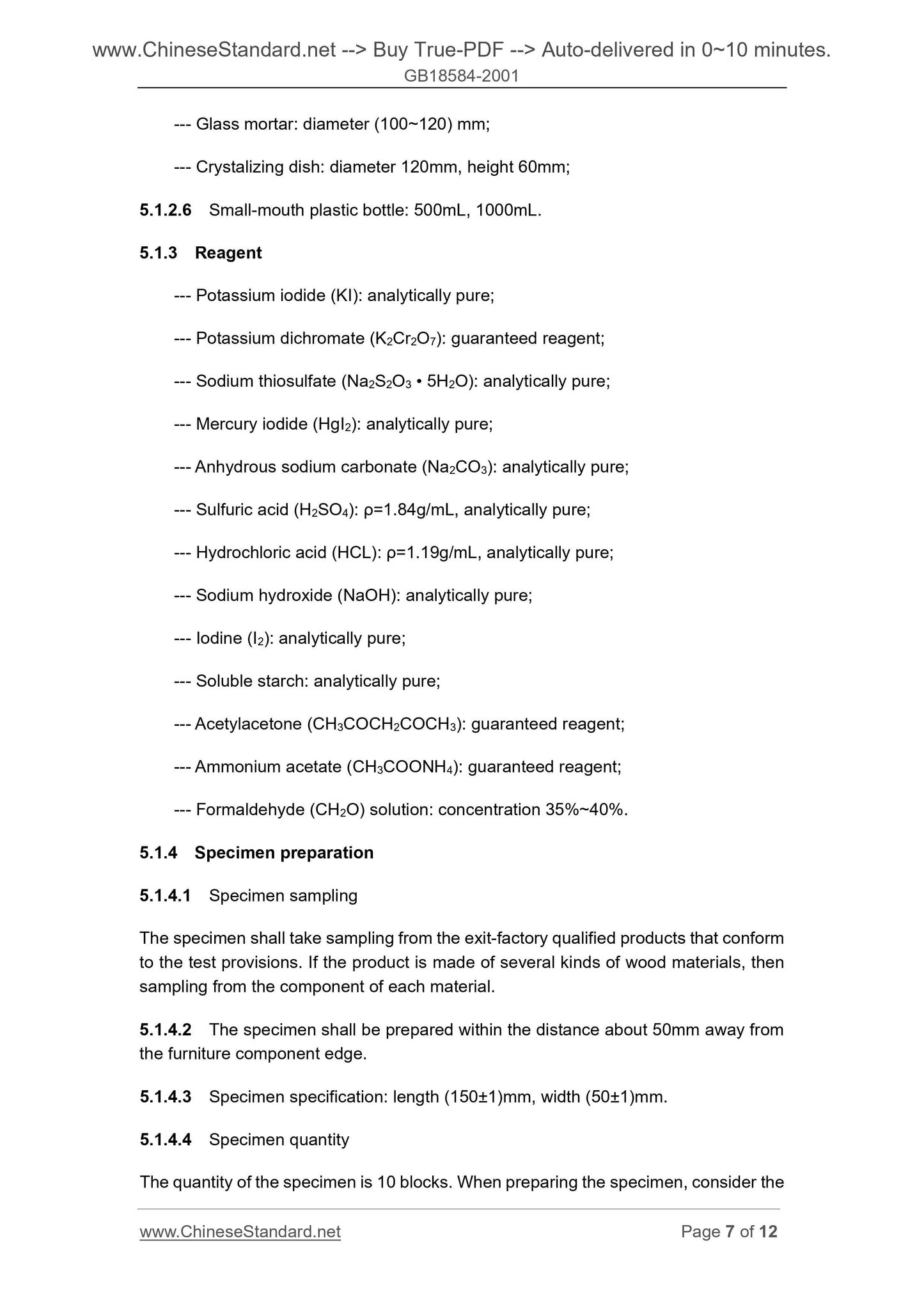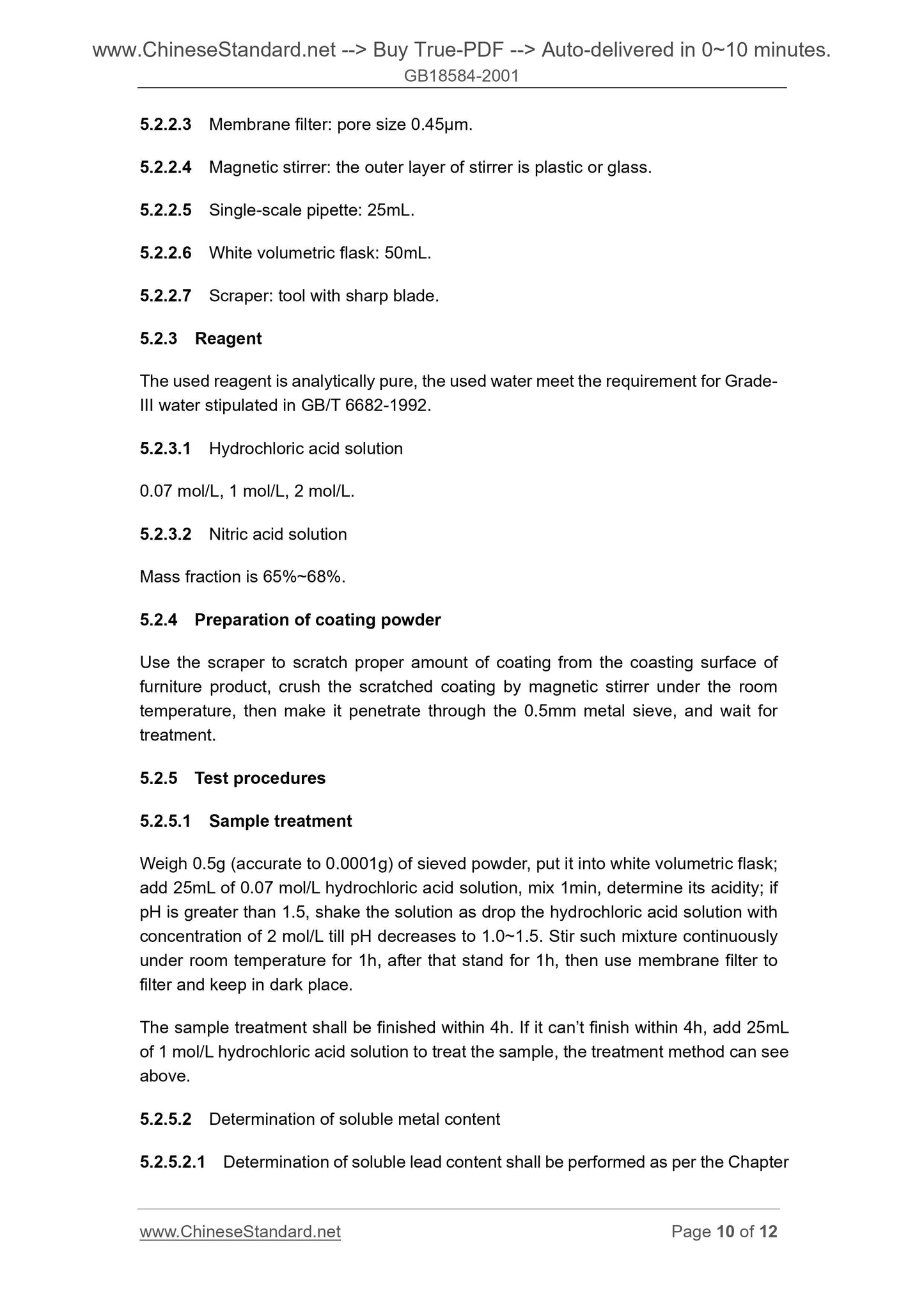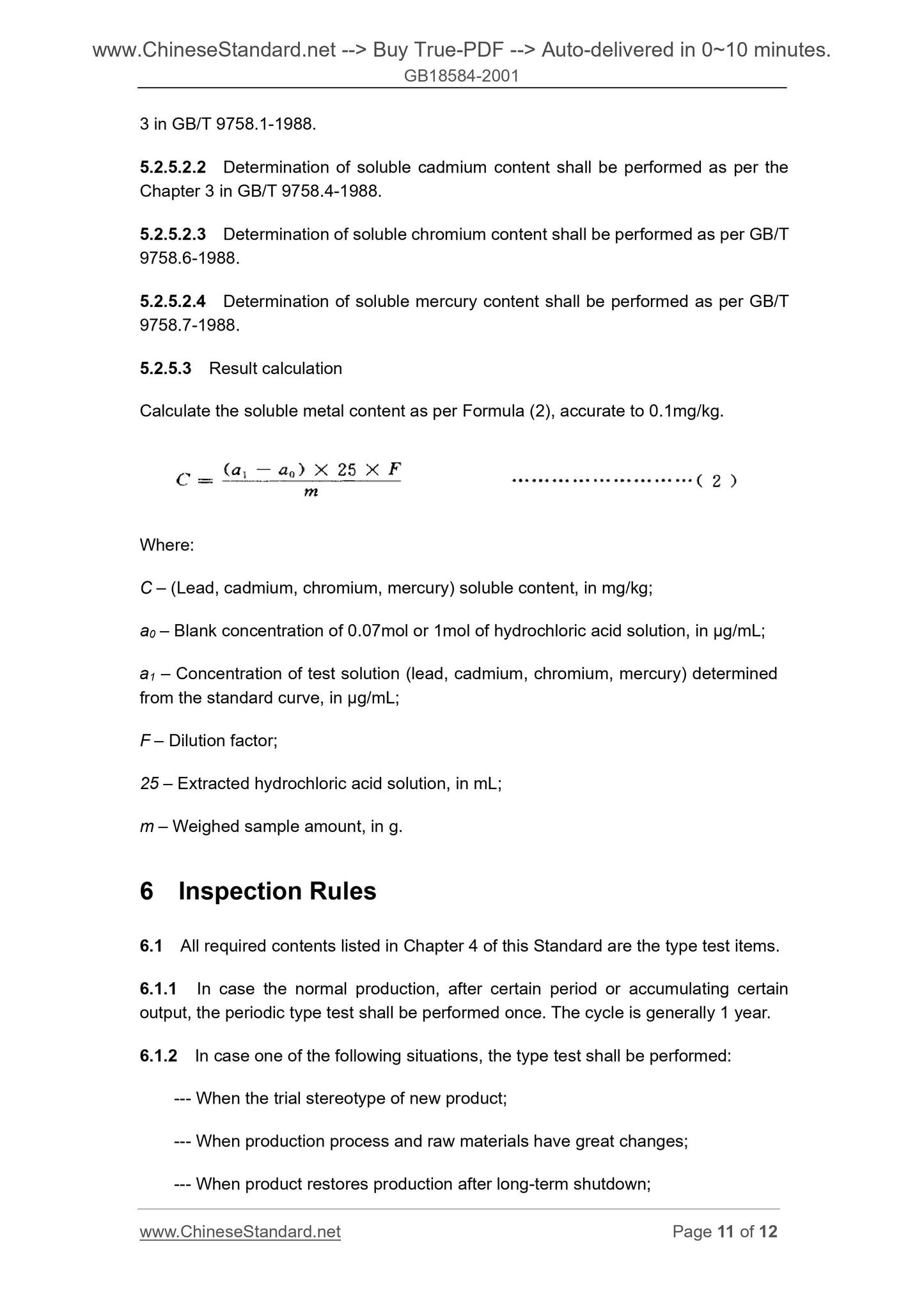1
/
of
7
PayPal, credit cards. Download editable-PDF & invoice in 1 second!
GB 18584-2001 English PDF (GB18584-2001)
GB 18584-2001 English PDF (GB18584-2001)
Regular price
$70.00 USD
Regular price
Sale price
$70.00 USD
Unit price
/
per
Shipping calculated at checkout.
Couldn't load pickup availability
Delivery: 3 seconds. Download true-PDF + Invoice.
Get QUOTATION in 1-minute: Click GB 18584-2001
Historical versions: GB 18584-2001
Preview True-PDF (Reload/Scroll if blank)
GB 18584-2001: Indoor decorating and refurbishing materials -- Limit of harmful substances of wood-based furniture
GB 18584-2001
GB
NATIONAL STANDARD OF THE
PEOPLE’S REPUBLIC OF CHINA
ICS 97.140
Y 80
Indoor Decorating and Refurbishing Materials –
Limit of Harmful Substance of Wood Based Furniture
ISSUED ON. DECEMBER 10, 2001
IMPLEMENTED ON. JANUARY 1, 2002
Issued by. General Administration of Quality Supervision, Inspection
and Quarantine
Table of Contents
Foreword ... 3
1 Scope ... 4
2 Normative Reference ... 4
3 Terms and Definitions ... 5
4 Requirements ... 5
5 Test Method ... 5
6 Inspection Rules ... 11
Foreword
The Chapter 4 in this Standard is mandatory, while the rest are recommended.
Since January 1, 2002, the products produced by the manufacturer shall implement
this Standard; the transition period is 6 months; Since July 1, 2002, the products that
don’t conform to this Standard shall stop selling on the market.
This Standard was proposed by China Light Industry Council.
This Standard shall be under the jurisdiction of National Standardization Center of
Furniture.
Drafting organizations of this Standard. National Standardization Center of Furniture,
School of Wood Industry of Nanjing Forestry University, and Beijing Building Materials
Academy of Sciences Research.
Participating drafting organizations of this Standard. Tiantan Furniture Branch of
Beijing Tiantan Co., Ltd., Beijing Easyhome Decoration Development Co., Ltd.,
Shenzhen Dafuhao Industrial Development Co., Ltd., Shunde Meihua Home
Manufacturing Co., Ltd., and Shunde Hualong Coating Industrial Co., Ltd.
Chief drafting staffs of this Standard. Zhang Binyuan, Liu Yaoguo, Luo Xin, Yu
Zhengrong, Gu Ming, Zhang Zengbiao, Wang Linpeng, He Xunzheng, Chen Weiheng,
and Mai Quan.
Indoor Decorating and Refurbishing Materials –
Limit of Harmful Substance of Wood Based Furniture
1 Scope
This Standard specifies the limit requirements, test methods and inspection rules for
the harmful substance in the indoor wood based furniture.
This Standard is applicable to the various indoor wood based furniture products.
2 Normative Reference
The following documents contain the provisions which, through reference in this
Standard, become the provisions of this Standard. For dated references, their
subsequent amendments (excluding corrigendum) or revisions do not apply to this
Standard. However, the parties who enter into agreement based on this Standard are
encouraged to investigate whether the latest versions of these documents are
applicable. For undated reference documents, the latest versions apply to this
Standard.
GB/T 6682-1992 Water for Analytical Laboratory Use - Specification and Test
Methods (neq ISO 3696.1987)
GB/T 9758.1-1988 Paints and Varnishes - Determination of “Soluble” Metal
Content -Part 1. Determination of Lead Content - Flame Atomic Absorption
Spectrometric Method and Dithizone Spectrophotometric Method (idt ISO 3856-
1.1984)
GB/T 9758.4-1988 Paints and Varnishes - Determination of “Soluble” Metal
Content - Part 4. Determination of Cadmium Content - Flame Atomic Absorption
Spectrometric Method and Polarographic Method (idt ISO 3856-4.1984)
GB/T 9758.6-1988 Paints and Varnishes - Determination of “Soluble” Metal
Content -Part 6. Determination of Total Chromium Content of the Liquid Portion of
the Paint - Flame Atomic Absorption Spectrometric Method (idt ISO 3856-6.1984)
GB/T 9758.7-1988 Paints and Varnishes - Determination of “Soluble” Metal
Content - Part 7. Determination of Mercury Content of the Pigment Portion of the
Paint and of the Liquid Portion of Water-Dilutable Paints - Flameless Atomic
--- Glass mortar. diameter (100~120) mm;
--- Crystalizing dish. diameter 120mm, height 60mm;
5.1.2.6 Small-mouth plastic bottle. 500mL, 1000mL.
5.1.3 Reagent
--- Potassium iodide (KI). analytically pure;
--- Potassium dichromate (K2Cr2O7). guaranteed reagent;
--- Sodium thiosulfate (Na2S2O3 • 5H2O). analytically pure;
--- Mercury iodide (HgI2). analytically pure;
--- Anhydrous sodium carbonate (Na2CO3). analytically pure;
--- Sulfuric acid (H2SO4). ρ=1.84g/mL, analytically pure;
--- Hydrochloric acid (HCL). ρ=1.19g/mL, analytically pure;
--- Sodium hydroxide (NaOH). analytically pure;
--- Iodine (I2). analytically pure;
--- Soluble starch. analytically pure;
--- Acetylacetone (CH3COCH2COCH3). guaranteed reagent;
--- Ammonium acetate (CH3COONH4). guaranteed reagent;
--- Formaldehyde (CH2O) solution. concentration 35%~40%.
5.1.4 Specimen preparation
5.1.4.1 Specimen sampling
The specimen shall take sampling from the exit-factory qualified products that conform
to the test provisions. If the product is made of several kinds of wood materials, then
sampling from the component of each material.
5.1.4.2 The specimen shall be prepared within the distance about 50mm away from
the furniture component edge.
5.1.4.3 Specimen specification. length (150±1)mm, width (50±1)mm.
5.1.4.4 Specimen quantity
The quantity of the specimen is 10 blocks. When preparing the specimen, consider the
5.2.2.3 Membrane filter. pore size 0.45µm.
5.2.2.4 Magnetic stirrer. the outer layer of stirrer is plastic or glass.
5.2.2.5 Single-scale pipette. 25mL.
5.2.2.6 White volumetric flask. 50mL.
5.2.2.7 Scraper. tool with sharp blade.
5.2.3 Reagent
The used reagent is analytically pure, the used water meet the requirement for Grade-
III water stipulated in GB/T 6682-1992.
5.2.3.1 Hydrochloric acid solution
0.07 mol/L, 1 mol/L, 2 mol/L.
5.2.3.2 Nitric acid solution
Mass fraction is 65%~68%.
5.2.4 Preparation of coating powder
Use the scraper to scratch proper amount of coating from the coasting surface of
furniture product, crush the scratched coating by magnetic stirrer under the room
temperature, then make it penetrate through the 0.5mm metal sieve, and wait for
treatment.
5.2.5 Test procedures
5.2.5.1 Sample treatment
Weigh 0.5g (accurate to 0.0001g) of sieved powder, put it into white volumetric flask;
add 25mL of 0.07 mol/L hydrochloric acid solution, mix 1min, determine its acidity; if
pH is greater than 1.5, shake the solution as drop the hydrochloric acid solution with
concentration of 2 mol/L till pH decreases to 1.0~1.5. Stir such mixture continuously
under room temperature for 1h, after that stand for 1h, then use membrane filter to
filter and keep in dark place.
The sample treatment shall be finished within 4h. If it can’t finish within 4h, add 25mL
of 1 mol/L hydrochloric acid solution to treat the sample, the treatment method can see
above.
5.2.5.2 Determination of soluble metal content
5.2.5.2.1 Determination of soluble lead content shall be performed as per the Chapter
3 in GB/T 9758.1-1988.
5.2.5.2.2 Determination of soluble cadmium content shall be performed as per the
Chapter 3 in GB/T 9758.4-1988.
5.2.5.2.3 Determination of soluble chromium content shall be performed as per GB/T
9758.6-1988.
5.2.5.2.4 Determination of soluble mercury content shall be performed as per GB/T
9758.7-1988.
5.2.5.3 Result calculation
Calculate the soluble metal content as per Formula (2), accurate to 0.1mg/kg.
Where.
C – (Lead, cadmium, chromium, mercury) soluble content, in mg/kg;
a0 – Blank concentration of 0.07mol or 1mol of hydrochloric acid solution, in µg/mL;
a1 – Concentration of test solution (lead, cadmium, chromium, mercury) determined
from the standard curve, in µg/mL;
F – Dilution factor;
25 – Extracted hydrochloric acid solution, in mL;
m – Weighed ...
Get QUOTATION in 1-minute: Click GB 18584-2001
Historical versions: GB 18584-2001
Preview True-PDF (Reload/Scroll if blank)
GB 18584-2001: Indoor decorating and refurbishing materials -- Limit of harmful substances of wood-based furniture
GB 18584-2001
GB
NATIONAL STANDARD OF THE
PEOPLE’S REPUBLIC OF CHINA
ICS 97.140
Y 80
Indoor Decorating and Refurbishing Materials –
Limit of Harmful Substance of Wood Based Furniture
ISSUED ON. DECEMBER 10, 2001
IMPLEMENTED ON. JANUARY 1, 2002
Issued by. General Administration of Quality Supervision, Inspection
and Quarantine
Table of Contents
Foreword ... 3
1 Scope ... 4
2 Normative Reference ... 4
3 Terms and Definitions ... 5
4 Requirements ... 5
5 Test Method ... 5
6 Inspection Rules ... 11
Foreword
The Chapter 4 in this Standard is mandatory, while the rest are recommended.
Since January 1, 2002, the products produced by the manufacturer shall implement
this Standard; the transition period is 6 months; Since July 1, 2002, the products that
don’t conform to this Standard shall stop selling on the market.
This Standard was proposed by China Light Industry Council.
This Standard shall be under the jurisdiction of National Standardization Center of
Furniture.
Drafting organizations of this Standard. National Standardization Center of Furniture,
School of Wood Industry of Nanjing Forestry University, and Beijing Building Materials
Academy of Sciences Research.
Participating drafting organizations of this Standard. Tiantan Furniture Branch of
Beijing Tiantan Co., Ltd., Beijing Easyhome Decoration Development Co., Ltd.,
Shenzhen Dafuhao Industrial Development Co., Ltd., Shunde Meihua Home
Manufacturing Co., Ltd., and Shunde Hualong Coating Industrial Co., Ltd.
Chief drafting staffs of this Standard. Zhang Binyuan, Liu Yaoguo, Luo Xin, Yu
Zhengrong, Gu Ming, Zhang Zengbiao, Wang Linpeng, He Xunzheng, Chen Weiheng,
and Mai Quan.
Indoor Decorating and Refurbishing Materials –
Limit of Harmful Substance of Wood Based Furniture
1 Scope
This Standard specifies the limit requirements, test methods and inspection rules for
the harmful substance in the indoor wood based furniture.
This Standard is applicable to the various indoor wood based furniture products.
2 Normative Reference
The following documents contain the provisions which, through reference in this
Standard, become the provisions of this Standard. For dated references, their
subsequent amendments (excluding corrigendum) or revisions do not apply to this
Standard. However, the parties who enter into agreement based on this Standard are
encouraged to investigate whether the latest versions of these documents are
applicable. For undated reference documents, the latest versions apply to this
Standard.
GB/T 6682-1992 Water for Analytical Laboratory Use - Specification and Test
Methods (neq ISO 3696.1987)
GB/T 9758.1-1988 Paints and Varnishes - Determination of “Soluble” Metal
Content -Part 1. Determination of Lead Content - Flame Atomic Absorption
Spectrometric Method and Dithizone Spectrophotometric Method (idt ISO 3856-
1.1984)
GB/T 9758.4-1988 Paints and Varnishes - Determination of “Soluble” Metal
Content - Part 4. Determination of Cadmium Content - Flame Atomic Absorption
Spectrometric Method and Polarographic Method (idt ISO 3856-4.1984)
GB/T 9758.6-1988 Paints and Varnishes - Determination of “Soluble” Metal
Content -Part 6. Determination of Total Chromium Content of the Liquid Portion of
the Paint - Flame Atomic Absorption Spectrometric Method (idt ISO 3856-6.1984)
GB/T 9758.7-1988 Paints and Varnishes - Determination of “Soluble” Metal
Content - Part 7. Determination of Mercury Content of the Pigment Portion of the
Paint and of the Liquid Portion of Water-Dilutable Paints - Flameless Atomic
--- Glass mortar. diameter (100~120) mm;
--- Crystalizing dish. diameter 120mm, height 60mm;
5.1.2.6 Small-mouth plastic bottle. 500mL, 1000mL.
5.1.3 Reagent
--- Potassium iodide (KI). analytically pure;
--- Potassium dichromate (K2Cr2O7). guaranteed reagent;
--- Sodium thiosulfate (Na2S2O3 • 5H2O). analytically pure;
--- Mercury iodide (HgI2). analytically pure;
--- Anhydrous sodium carbonate (Na2CO3). analytically pure;
--- Sulfuric acid (H2SO4). ρ=1.84g/mL, analytically pure;
--- Hydrochloric acid (HCL). ρ=1.19g/mL, analytically pure;
--- Sodium hydroxide (NaOH). analytically pure;
--- Iodine (I2). analytically pure;
--- Soluble starch. analytically pure;
--- Acetylacetone (CH3COCH2COCH3). guaranteed reagent;
--- Ammonium acetate (CH3COONH4). guaranteed reagent;
--- Formaldehyde (CH2O) solution. concentration 35%~40%.
5.1.4 Specimen preparation
5.1.4.1 Specimen sampling
The specimen shall take sampling from the exit-factory qualified products that conform
to the test provisions. If the product is made of several kinds of wood materials, then
sampling from the component of each material.
5.1.4.2 The specimen shall be prepared within the distance about 50mm away from
the furniture component edge.
5.1.4.3 Specimen specification. length (150±1)mm, width (50±1)mm.
5.1.4.4 Specimen quantity
The quantity of the specimen is 10 blocks. When preparing the specimen, consider the
5.2.2.3 Membrane filter. pore size 0.45µm.
5.2.2.4 Magnetic stirrer. the outer layer of stirrer is plastic or glass.
5.2.2.5 Single-scale pipette. 25mL.
5.2.2.6 White volumetric flask. 50mL.
5.2.2.7 Scraper. tool with sharp blade.
5.2.3 Reagent
The used reagent is analytically pure, the used water meet the requirement for Grade-
III water stipulated in GB/T 6682-1992.
5.2.3.1 Hydrochloric acid solution
0.07 mol/L, 1 mol/L, 2 mol/L.
5.2.3.2 Nitric acid solution
Mass fraction is 65%~68%.
5.2.4 Preparation of coating powder
Use the scraper to scratch proper amount of coating from the coasting surface of
furniture product, crush the scratched coating by magnetic stirrer under the room
temperature, then make it penetrate through the 0.5mm metal sieve, and wait for
treatment.
5.2.5 Test procedures
5.2.5.1 Sample treatment
Weigh 0.5g (accurate to 0.0001g) of sieved powder, put it into white volumetric flask;
add 25mL of 0.07 mol/L hydrochloric acid solution, mix 1min, determine its acidity; if
pH is greater than 1.5, shake the solution as drop the hydrochloric acid solution with
concentration of 2 mol/L till pH decreases to 1.0~1.5. Stir such mixture continuously
under room temperature for 1h, after that stand for 1h, then use membrane filter to
filter and keep in dark place.
The sample treatment shall be finished within 4h. If it can’t finish within 4h, add 25mL
of 1 mol/L hydrochloric acid solution to treat the sample, the treatment method can see
above.
5.2.5.2 Determination of soluble metal content
5.2.5.2.1 Determination of soluble lead content shall be performed as per the Chapter
3 in GB/T 9758.1-1988.
5.2.5.2.2 Determination of soluble cadmium content shall be performed as per the
Chapter 3 in GB/T 9758.4-1988.
5.2.5.2.3 Determination of soluble chromium content shall be performed as per GB/T
9758.6-1988.
5.2.5.2.4 Determination of soluble mercury content shall be performed as per GB/T
9758.7-1988.
5.2.5.3 Result calculation
Calculate the soluble metal content as per Formula (2), accurate to 0.1mg/kg.
Where.
C – (Lead, cadmium, chromium, mercury) soluble content, in mg/kg;
a0 – Blank concentration of 0.07mol or 1mol of hydrochloric acid solution, in µg/mL;
a1 – Concentration of test solution (lead, cadmium, chromium, mercury) determined
from the standard curve, in µg/mL;
F – Dilution factor;
25 – Extracted hydrochloric acid solution, in mL;
m – Weighed ...
Share
